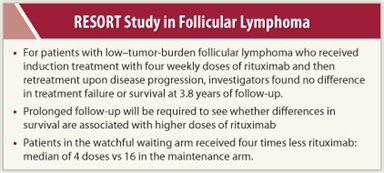For patients with low–tumor-burden follicular lymphoma treated upfront with rituximab (Rituxan), retreating upon disease progression was as effective as extended dosing, or maintenance therapy, in a randomized phase III study that compared the approaches.1
 Given the excellent outcomes, lack of a difference in quality of life, and fewer doses required with retreatment, “rituximab retreatment is our recommended strategy if opting for rituximab monotherapy in low–tumor-burden follicular lymphoma,” said Brad Kahl, MD, Associate Professor of Medicine at the University of Wisconsin School of Medicine and Public Health in Madison, who presented the late-breaking abstract at the 2011 ASH Annual Meeting.
Given the excellent outcomes, lack of a difference in quality of life, and fewer doses required with retreatment, “rituximab retreatment is our recommended strategy if opting for rituximab monotherapy in low–tumor-burden follicular lymphoma,” said Brad Kahl, MD, Associate Professor of Medicine at the University of Wisconsin School of Medicine and Public Health in Madison, who presented the late-breaking abstract at the 2011 ASH Annual Meeting.
Trial Results
The Eastern Cooperative Oncology Group conducted the RESORT trial (Rituximab Extended Schedule or Retreatment Trial) to compare maintenance rituximab vs retreatment upon progression. The study included 545 untreated patients with stage III or IV indolent non-Hodgkin lymphoma and low tumor burden, including 384 with follicular lymphoma histology who formed the basis of this analysis. The presentation at the ASH Annual Meeting was restricted to those patients with follicular lymphoma only. The other histologies will be analyzed later.
Patients were treated with rituximab in the standard manner, and the 274 (71%) responders were randomly assigned to single-dose rituximab every 3 months until treatment failure or to observation and retreatment upon disease progression.
 “At a median follow-up of 3.8 years, there was absolutely no difference in the primary endpoint of time to treatment failure,” Dr. Kahl reported. Time to rituximab failure—defined as progression within 6 months of last rituximab, no response to rituximab retreatment, initiation of alternative therapy, or inability to complete protocol therapy—was 3.9 years for maintenance rituximab and 3.6 years with retreatment (P = .80).
“At a median follow-up of 3.8 years, there was absolutely no difference in the primary endpoint of time to treatment failure,” Dr. Kahl reported. Time to rituximab failure—defined as progression within 6 months of last rituximab, no response to rituximab retreatment, initiation of alternative therapy, or inability to complete protocol therapy—was 3.9 years for maintenance rituximab and 3.6 years with retreatment (P = .80).
Rituximab failures occurred in 69 patients on the maintenance arm and 65 in the retreatment arm. Time to first chemotherapy treatment was longer in the maintenance arm, with 95% of patients remaining chemotherapy-free compared to 86% in the retreatment arm (P = .03).
“But both strategies appear to delay time to chemotherapy, compared to historical controls,” he observed.
Additional Findings
 There were no appreciable differences in toxicity, or the development of second cancers, between the arms. More patients in the maintenance arm withdrew from the trial—26 vs 16 in the retreatment arm.
There were no appreciable differences in toxicity, or the development of second cancers, between the arms. More patients in the maintenance arm withdrew from the trial—26 vs 16 in the retreatment arm.
“We also wondered if there might be a psychological benefit to being maintained in remission, but at 1 year postrandomization we found no difference in quality of life,” Dr. Kahl reported.
One difference, however, did stand out: The amount of rituximab delivered per patient was 15.8 doses in the maintenance arm compared to only 4.5 for retreated patients. Number of doses ranged from 5 to 31 with maintenance and from 4 to 16 with observation and retreatment.
“Rituximab retreatment was as effective as maintenance rituximab in terms of time to treatment failure. And while maintenance was superior to retreatment in terms of time to cytotoxic therapy, this came at a cost of nearly 4 times more rituximab,” Dr. Kahl concluded. “There was also no benefit in terms of quality of life or less anxiety at 12 months with maintenance.”■
Disclosure: Dr. Kahl is a consultant for Genentech and Roche.
Expert Point of View: Maintenance Rituximab vs Retreatment Rituximab in Patients with Low–Tumor-Burden Follicular Lymphoma
Reference
1. Kahl B, Hong F, Williams ME, et al: Results of Eastern Cooperative Oncology Group Protocol E4402 (RESORT): A randomized phase III study comparing two different rituximab dosing strategies for low tumor burden follicular lymphoma. 53rd American Society of Hematology Annual Meeting. Abstract LBA-6. Presented December 13, 2011

 The findings of RESORT1 have tremendous implications, both clinically and economically, commented Andrew D. Zelenetz, MD, Chief of the Lymphoma Service at Memorial Sloan-Kettering Cancer Center, New York, in an interview.
The findings of RESORT1 have tremendous implications, both clinically and economically, commented Andrew D. Zelenetz, MD, Chief of the Lymphoma Service at Memorial Sloan-Kettering Cancer Center, New York, in an interview.